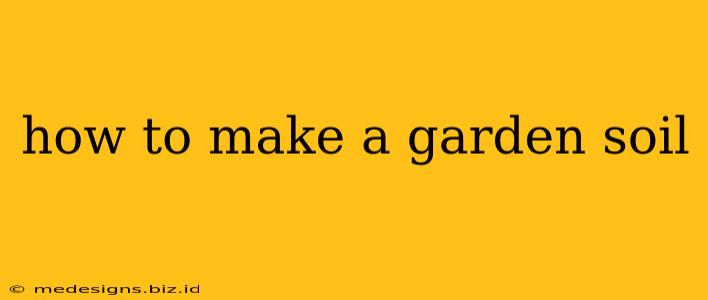Creating rich, healthy garden soil is the cornerstone of successful gardening. Forget struggling with poor soil – learn how to craft the ideal growing medium for your plants to thrive! This comprehensive guide will walk you through the process, step-by-step.
Understanding Your Soil's Needs
Before you start mixing, you need to understand your existing soil. A simple soil test (available at most garden centers) will reveal its pH level and nutrient content. This information is crucial for determining what amendments are needed. Is your soil:
- Clayey? Clay soil is dense, retains water, and can be difficult for roots to penetrate.
- Sandy? Sandy soil drains too quickly, leading to nutrient loss and frequent watering.
- Silty? Silty soil is generally fertile but can become compacted.
- Rocky? Rocky soil requires significant amendment to create planting pockets.
Knowing your soil type helps you tailor your soil-making process.
Essential Components of Great Garden Soil
The key to fantastic garden soil is a balanced blend of three crucial elements:
- Mineral Matter: This forms the soil's structure. For example, sand, silt, and clay.
- Organic Matter: This improves soil structure, water retention, and nutrient availability. Think compost, peat moss, and aged manure.
- Living Organisms: Beneficial microbes, worms, and other soil life are essential for nutrient cycling and overall soil health.
Building Your Ideal Garden Soil Mix: A Step-by-Step Guide
Here's how to create a thriving soil mix, adapting it to your specific soil type:
1. Assess Your Existing Soil
Conduct a soil test to determine its pH and nutrient levels. This informs the amendments you'll need.
2. Gather Your Materials
You'll need the following, adjusting quantities based on the size of your garden and your soil test results:
- Compost: The cornerstone of healthy soil. Aim for a mature, well-rotted compost.
- Aged Manure: Adds nutrients and improves soil structure (avoid fresh manure, which can burn plants).
- Peat Moss (Optional): Improves drainage and aeration, particularly beneficial for clay soils. Consider alternatives like coconut coir for a more sustainable option.
- Sand (Optional): Improves drainage in heavy clay soils.
- Clay (Optional): Improves water retention in sandy soils.
- Soil Conditioner: Improves soil structure and fertility.
3. Mixing Your Soil
There's no single "perfect" ratio. The ideal mix depends on your soil type and the plants you're growing. Here are some general guidelines:
- For Clay Soil: Mix 1 part compost, 1 part peat moss (or coconut coir), and 1 part sand with 2-3 parts of your existing clay soil.
- For Sandy Soil: Mix 1 part compost, 1 part clay, and 2 parts of your existing sandy soil.
- For Silty Soil: Mix compost at a ratio of 1:3 with your existing soil. Add additional organic matter as needed.
4. Incorporate Amendments
Work the chosen amendments into your existing soil thoroughly. Use a garden fork or tiller to ensure even distribution.
5. Test Your Soil pH
After amending your soil, consider re-testing the pH. You may need to adjust with lime (to raise pH) or sulfur (to lower pH).
6. Adding Beneficial Microbes (Optional)
Introduce beneficial microbes with a commercially available inoculant. These microorganisms enhance nutrient cycling and root development.
Maintaining Healthy Garden Soil
Creating great garden soil is an ongoing process. Here are some key practices to maintain soil health:
- Regular Mulching: Mulch suppresses weeds, retains moisture, and adds organic matter as it decomposes.
- Cover Cropping: Planting cover crops during fallow periods adds nutrients and improves soil structure.
- Composting: Continuously compost kitchen scraps and yard waste to create a regular supply of rich organic matter.
- Avoid Over-tilling: Excessive tilling can damage soil structure and harm beneficial microorganisms.
By following these steps, you can transform your garden soil into a fertile oasis where your plants will flourish! Remember, patience and consistent effort are key to building and maintaining healthy, productive garden soil.
